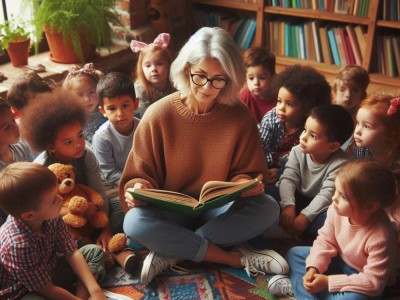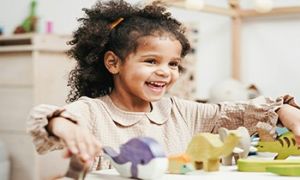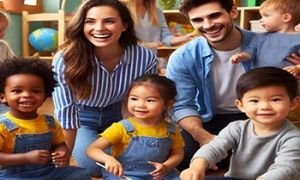Storytelling is a powerful tool in early childhood education, offering numerous benefits for children's development. The following article provides information on the Benefits Of Storytelling, Best Ways To Read To Children, Best Books For Babies, Toddlers, Preschoolers and more.
Benefits Of Storytelling
-
Language Development: Storytelling helps children develop their vocabulary, comprehension, and communication skills. It introduces them to new words and phrases in a meaningful context.
-
Imagination and Creativity: Listening to stories stimulates children's imagination and encourages creative thinking. They learn to visualize characters, settings, and events, which enhances their ability to create their own stories.
-
Emotional Understanding: Stories often explore a range of emotions and situations, helping children understand and express their own feelings. They learn empathy by identifying with characters and their experiences.
-
Cultural Awareness: Storytelling exposes children to different cultures, traditions, and perspectives. It broadens their understanding of the world and fosters appreciation for diversity.
-
Cognitive Skills: Engaging with stories improves children's memory, attention, and critical thinking skills. They learn to follow a narrative, predict outcomes, and make connections between different parts of the story.
-
Moral Lessons: Many stories convey important moral lessons and values. Children learn about right and wrong, kindness, honesty, and other virtues through the actions and consequences faced by characters.
-
Bonding and Social Skills: Storytelling sessions provide opportunities for children to bond with their caregivers and peers. It encourages listening, turn-taking, and participation in group activities.
Incorporating storytelling into early childhood education can significantly enhance children's overall development and create a love for reading and learning that lasts a lifetime.
Best Way To Read To Children
Reading to children is a wonderful way to bond and support their development. Here are some tips for making the most of storytime:
-
Choose Age-Appropriate Books: Select books that are suitable for the child's age and interests. For babies, board books with simple pictures and repetitive text are great. For toddlers and preschoolers, choose books with engaging stories and colorful illustrations.
-
Create a Cozy Reading Environment: Find a comfortable and quiet spot where you can read together without distractions. This helps create a positive and enjoyable reading experience.
-
Use Expressive Voices: Bring the story to life by using different voices for different characters and adding emotion to your reading. This makes the story more engaging and fun for the child.
-
Encourage Participation: Ask questions about the story, let the child turn the pages, and encourage them to point out pictures or repeat phrases. This helps keep them engaged and involved.
-
Make It a Routine: Establish a regular reading routine, such as before bedtime or after meals. Consistency helps children look forward to storytime and develop a love for reading.
-
Discuss the Story: After reading, talk about the story with the child. Ask them what they liked, what they learned, and how they felt about the characters and events. This helps develop their comprehension and critical thinking skills.
-
Be Patient and Responsive: Follow the child's lead and be patient if they want to spend more time on certain pages or ask questions. Respond to their curiosity and encourage their interest in the story.
By incorporating these tips, you can make reading a delightful and enriching experience for children, fostering their love for books and learning.
Best Books For Babies
-
Goodnight Moon by Margaret Wise Brown
-
The Very Hungry Caterpillar by Eric Carle
-
Brown Bear, Brown Bear, What Do You See? by Bill Martin Jr. and Eric Carle
-
The Going to Bed Book by Sandra Boynton
-
Corduroy by Don Freeman
-
Peekaboo Bear by Camilla Reid and Ingela P. Arrhenius
-
Where's Spot? by Eric Hill
-
Everywhere Babies by Susan Meyers and Marla Frazee
-
Goodnight Moon by Margaret Wise Brown and Clement Hurd
-
The Runaway Bunny by Margaret Wise Brown
Best Books For Toddlers
-
The Very Hungry Caterpillar by Eric Carle
-
Goodnight Moon by Margaret Wise Brown
-
Brown Bear, Brown Bear, What Do You See? by Bill Martin Jr. and Eric Carle
-
Where the Wild Things Are by Maurice Sendak
-
Llama Llama Red Pajama by Anna Dewdney
-
Guess How Much I Love You by Sam McBratney
-
The Gruffalo by Julia Donaldson
-
Moo, Baa, La La La! by Sandra Boynton
-
Dragons Love Tacos by Adam Rubin
-
Our Skin: A First Conversation About Race by Megan Madison and Jessica Ralli
Best Books For Preschoolers
- Where the Wild Things Are by Maurice Sendak
-
The Very Hungry Caterpillar by Eric Carle
-
Brown Bear, Brown Bear, What Do You See? by Bill Martin Jr. and Eric Carle
-
Goodnight Moon by Margaret Wise Brown
-
The Gruffalo by Julia Donaldson
-
Llama Llama Red Pajama by Anna Dewdney
-
Guess How Much I Love You by Sam McBratney
-
Chicka Chicka Boom Boom by Bill Martin Jr. and John Archambault
-
The Snowy Day by Ezra Jack Keats
-
Room on the Broom by Julia Donaldson
These books are filled with engaging stories, colorful illustrations, and interactive elements that are perfect for children.
Further Reading
Importance Of Reading To Children
ANZAC Day Story Books For Children
Take Home Book Program For Preschoolers
Birdie Storybooks On Natural Disasters







 As an Educator in Australia, your pay rate falls under the Children’s Services Award 2010. This award states the minimum amount that an employer can
As an Educator in Australia, your pay rate falls under the Children’s Services Award 2010. This award states the minimum amount that an employer can When working as a qualified Early Childhood Teacher (with a university degree) within a service, your rate of pay will come from the Educational Services
When working as a qualified Early Childhood Teacher (with a university degree) within a service, your rate of pay will come from the Educational Services When working as a Diploma Qualified Educator your pay rate is from the Children's Services Award 2010. This Award states your minimum rate of pay
When working as a Diploma Qualified Educator your pay rate is from the Children's Services Award 2010. This Award states your minimum rate of pay When working as a Cert 3 Qualified Educator, your pay rate is from the Children's Services Award 2010. This Award states your minimum rate of
When working as a Cert 3 Qualified Educator, your pay rate is from the Children's Services Award 2010. This Award states your minimum rate of Educational Leaders play a crucial role in their early childhood service by ensuring that the educational program aligns with best practices and supports the holistic
Educational Leaders play a crucial role in their early childhood service by ensuring that the educational program aligns with best practices and supports the holistic In early childhood education and care, ratios are more than a technicality—they are a frontline safeguard. Every child deserves responsive supervision, emotional connection, and developmental
In early childhood education and care, ratios are more than a technicality—they are a frontline safeguard. Every child deserves responsive supervision, emotional connection, and developmental Here’s a comprehensive Mobile Phone and Smart Watch Policy tailored for early childhood education and care (ECEC) services in Australia, aligned with the latest 2025
Here’s a comprehensive Mobile Phone and Smart Watch Policy tailored for early childhood education and care (ECEC) services in Australia, aligned with the latest 2025 With the new national child safety reforms kicking in on 1 September 2025, early childhood services like yours have a real opportunity to lead the
With the new national child safety reforms kicking in on 1 September 2025, early childhood services like yours have a real opportunity to lead the The Sea of Fish Challenge is a national initiative that invites children, educators, families, and communities to create and display fish artworks as a symbol
The Sea of Fish Challenge is a national initiative that invites children, educators, families, and communities to create and display fish artworks as a symbol Across the early childhood education and care sector, educators are sounding the alarm: current staffing ratios are insufficient to deliver safe, meaningful, and developmentally appropriate
Across the early childhood education and care sector, educators are sounding the alarm: current staffing ratios are insufficient to deliver safe, meaningful, and developmentally appropriate


